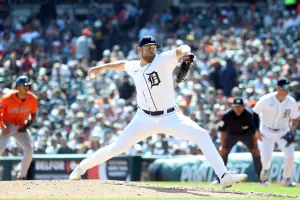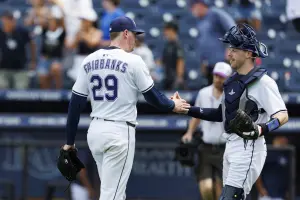
(*) RELIEVERS: Big skill sets, high ERAs
This week, we find 50 or so relievers with a BPV at or over 130 after April. This column narrows that list to a more interesting one--relievers with 10 or more innings where the actual ERA is 4.00 or higher, in spite of the 130+ BPV. Here is that interesting list:
IP ERA WHIP Dom Cmd HR/9 xERA G/F BPV pxERA pBPV
================= ==== ==== ==== ==== ==== ==== ==== ===== === ===== ====
H.Bell (ARI) 12.3 5.11 1.54 13.1 6.0 1.5 2.60 38/28 193 3.71 85
S.Kelley (NYY) 11.3 7.94 1.50 13.5 4.2 3.2 3.17 40/47 175 4.06 91
C.Capps (SEA) 16.0 4.50 1.38 11.8 7.0 2.2 3.42 27/53 172 3.25 131
D.Storen (WAS) 11.3 4.76 1.41 9.5 12.0 1.6 3.46 43/43 171 3.43 103
B.Gomes (TAM) 11.3 5.56 1.06 11.9 7.5 1.6 3.41 19/70 169 3.70 118
B.Badenhop (MIL) 10.7 4.22 1.03 8.4 10.0 1.7 2.67 53/20 160 3.50 86
K.Herrera (KC) 12.3 5.11 1.30 13.9 3.8 3.6 3.14 31/52 160 3.00 125
G.Perkins (MIN) 10.7 4.22 1.12 13.5 4.0 0.8 2.81 26/43 156 3.36 119 (L)
B.Kintzler (MIL) 13.0 5.54 1.23 9.7 4.7 0.7 2.84 46/23 142 3.85 63This short list of nine relievers features huge Dom and high Cmd. It also features exceedingly low xERA and in most cases, a good projected xERA and BPV. A BPV between 142 and 193 is as good as it gets. Yet all nine have a terrible ERA to date and many have a terrible WHIP as well. Most of this anomaly is created by a poor HR/9 (anything over 1.0). HR/9 should normalize over time, as the innings go up from 10-16 innings. But there are individual characteristics worth pointing out as well. Let's separate them into NL and AL and start this time in the NL.
Heath Bell (RHP, ARI) was successful as the Padres closer. Then he was awful last season as the Marlins closer. For 2013, he is with Arizona in set-up and so far, has a sparkling 13.1 Dom, 6.0 Cmd and 2.60 xERA. His 38/28 G/F ratio is acceptable--but it also means that 34% of the balls in play are line drives, which is why his WHIP is 1.54--a lousy BABIP off those liners. Bell also suffers from a 1.5 HR/9, which given the rest of his demonstrated skill set, is quite unlucky. So Bell is pitching very well, but challenging too many hitters and giving up liners and homers in bunches, which is why he has a 5.11 ERA and 1.54 WHIP.
The 2.60 xERA and 193 BPV should give owners hope, however. These are elite BPIs and far exceed Bell's projected 3.71 xERA and 85 pBPV, both of which are perfectly acceptable. Owners should expect better results from Bell's skills. Probably not back to the 2009, 2010 skill level (which is what the 2.60 and 193 indicate), but certainly back to the 3.71 pxERA level. Given some of the troubles that J.J. Putz (RHP, ARI) has been having, it may not be the worst idea to get Bell for pennies on the dollar and see what happens with Putz.
Owners doing this have to remember that David Hernandez is also in set up. Hernandez has had his own issues so far in 2013--great Dom, but far lesser Cmd. Hernandez appears to be Plan B for now, as well, but with a blown save to his credit against the Giants, Bell can get into the picture if his results just start to match his displayed skills to date.
Washington replaced closer Drew Storen (RHP, WAS) this offseason with Rafael Soriano (RHP, WAS). Storen has long had elite skills and so far this year, the 3.46 xERA and 171 BPV match the projected 3.43 xERA and exceed the projected 103 BPV. Storen's sole issue is the 1.6 HR/9 and an elevated BABIP--same as Heath Bell. Storen's projections are much brighter than Bell's, though, and his road to saves is blocked only by Soriano's effectiveness and health. Storen cannot remain the Plan B closer witha 4.76 actual ERA, however. His skills to date say this shall pass and his projections agree. Now makes the perfect time to acquire him, especially in keeper leagues where he could be reinstated as closer in 2014. For now, count on his ERA and WHIP dropping into line with his skills and projections because that 1.6 HR/9 and BABIP will normalize over more innings and, of course, monitor Soriano.
As much trouble as Milwaukee has had in its pen, is it any surprise that there are two Brewers on this list of nine--Burke Badenhop (RHP, MIL) and Brandon Kintzler (RHP, MIL)? On the surface, it appears as though only Jim Henderson (RHP, MIL) is performing well. But Badenhop has a strong Dom and Cmd, but again, with a 1.7 HR/9 that turns a 2.67 xERA into a 4.22 actual ERA, despite a 1.03 WHIP. Badenhop has a 53/20 G/F ratio, so the 1.7 HR/9 is a complete anomaly and will go down. As Badenhop's ERA improves, expect it to trend toward his projections--3.50 xERA and 86 BPV. It is a shame that Badenhop can be playing so far over his projected skills and yet suffer an artificially high actual ERA. Do not expect Badenhop to enter into the saves picture.
Kintzler's situation is even more bizarre. He is one of the two pitchers on this list without HR/9 problems. Kintzler has a 0.7 HR/9 to go with a 4.7 Cmd and 9.7 Dom. His G/F is 46/23. So why is Kintzler's actual ERA 5.54 when his xERA is 2.84? His strand rate is just exceedingly low--an anomaly that can occur in just 13 innings. Kintzler is doing everything right--but every baserunner seems to be scoring against him. Kintzler's bad luck will keep him away from the meaningful parts of games for now, but the skills to date are elite.
Shifting to the AL, Shawn Kelley (RHP, NYY) is not going to supplant Mariano Rivera (RHP, NYY) any time soon. Kelley has a whopping 3.2 HR/9 causing his problems, and with a 47% FB rate, those home runs could keep on flying out--especially with Yankee Stadium. So while Kelley has the huge Dom and Cmd, he will be hard-pressed to come anywhere near results anticipated by his xERA of 3.17 or BPV of 175 until he fixes the FB rate. Kelley has a projected 4.06 xERA and 91 BPV. Those skills are ok, but not really rosterable in most leagues from a middle reliever and with the FB rate from a Yankees' reliever, it is best to stay away in spite of the current 175 BPV and 3.17 xERA.
Seattle rookie Carter Capps (RHP, SEA) has some lofty projections with a 3.25 projected xERA and 131 projected BPV. He has not disappointed, with a 172 actual BPV and 3.42 xERA after 16 innings. Capps is giving the Mariners the skill set that was projected—on the surface, a far better one than current closer Tom Wilhelmsen (RHP, SEA). But Capps also has a 2.2 HR/9 that is supported by a 27/53 G/F tilt. Capps can certainly have a 4.50 actual ERA instead of a 3.42 xERA as long as he continues to have a 2.2 HR/9. Capps needs to fix the G/F tilt or at least reduce it sufficiently to fix the HR/9. Otherwise, he will remain an elite skill set with a poor actual ERA. But if he can make the adjustment and reduce the flyballs, Capps is elite and will eventually close games.
Brandon Gomes (RHP, TAM) has an absurd 19/70 G/F ratio. He is actually lucky that his HR/9 is only 1.6. The Dom and Cmd are superb, but it won't matter if 70 percent of the balls in play are flyballs. Gomes has a 1.06 WHIP. The 5.56 ERA instead of 3.41 xERA is probably too high even with the 1.6 HR/9--a strand rate problem. Gomes has a nice 3.70 projected xERA and 118 projected BPV. He has strong projected skills--3.70 pxERA and 118 pBPV. Watch the flyball rate come down. If it does (to something below 40 percent), then his actual ERA should head towards the projected xERA.
Kelvin Herrera (RHP, KC) is tantalizingly close to being the Royals closer. But Greg Holland (RHP, KC) has elite skills too. It doesn't help Herrera that his actual ERA is 5.11. A 3.6(!) HR/9 ruins his 13.9 Dom and 3.8 Cmd, turning his 3.14 xERA into a 5.11 actual ERA. The 52% FB rate is mostly to blame. It is not really like Herrera. In 2012, his G/F ratio was 56/25. In April 2013, it is flipped on its head. Expect that to reverse and for Herrera's skills to match his projected 3.00 pxERA and 125 pBPV. Herrera remains an elite power arm and while he may remain as Plan B for a while, he should produce a profitable ERA/WHIP.
Last, but by no means least, the one left-hander on the list is also the one closer on the list--Minnesota closer Glen Perkins (LHP, MIN). Perkins is the other reliever with an acceptable HR/9 on this list. In fact, across the board, it is hard to ask for better than 13.5 Dom, 4.0 Cmd, 0.8 HR/9, 2.81 xERA, 156 BPV. The 26/43 G/F tilt is not good for keeping the ball in the park, but with a 0.8 HR/9, it does not explain the 4.22 actual ERA instead of 2.81 xERA--especially with a 1.12 WHIP. It is all strand rate--driven, and with only 10.7 innings, it is anomalous. Expect Perkins to produce in line with projections--pxERA 3.36 and pBPV 119. So the 4.22 actual ERA may give you a small discount/buying window--certainly worth a call to see what can be done in trade with a Perkins owner.
Next week, we give you some sell high candidates.







